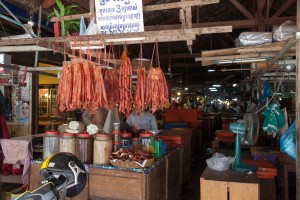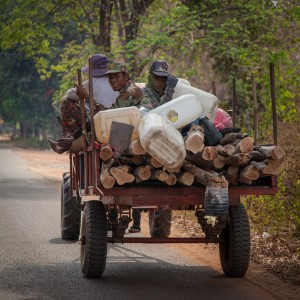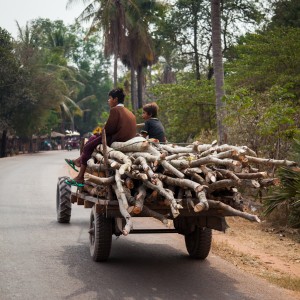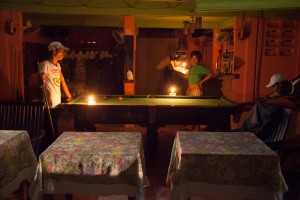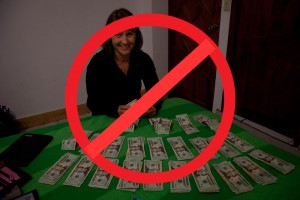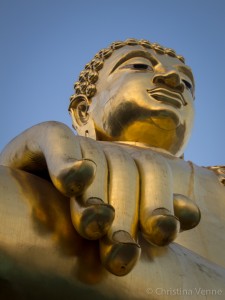 By following the well worn backpacker trail through northern and central Laos, we caught a glimpse of a country of contrasts where rural and urban life often seemed worlds apart. Even though the journey between these tourist hotspots is on paved roads as compared to 80% of the country’s roadways which are dirt, travel is still difficult in this country.
By following the well worn backpacker trail through northern and central Laos, we caught a glimpse of a country of contrasts where rural and urban life often seemed worlds apart. Even though the journey between these tourist hotspots is on paved roads as compared to 80% of the country’s roadways which are dirt, travel is still difficult in this country.
Buses travel at an average speed of about 40-50 km hour, primarily because of the mountainous terrain and the pot-hole riddled roads. This made for long and very uncomfortable road trips in equally uncomfortable so-called VIP buses, which are nothing more than retired Chinese tour buses. In fact, we would rate the buses in Laos amongst the worst we have seen in all our travels. Not only were they old and filthy, they were designed for very short people – even I felt cramped for leg room!
Our time in Laos was concentrated in two popular urban centres: Luang Prabang, a UNESCO World Heritage Site, and the nation’s capital, Vientiane. We also spent a couple of nights in Vang Vieng, a small town half way between Luang Prabang and Vientiane.
Luang Prabang: Set at the confluence of the Mekong and Nam Khan Rivers, beneath a temple-topped hill, this tidy little city oozes charm and personality. It’s too bad it has been invaded by hordes of tourists, many of whom come by the bus load from their neighbour to the north, China.
 The city awakens at 6:00 am to the sound of pots clanging as hundreds of monks and novices walk through the streets collecting their alms for the day – food offered by kneeling villagers and tourists that will provide daily sustenance for the monk. Sadly, this ceremony has become a major tourist attraction with disastrous consequences to the monks, to the point where some monks want to put an end to this long-held tradition. But the government is forcing them to continue this tourist pageant or risk being replaced with lay people clothed in saffron robes in order to keep up appearances, and thereby maintain tourist revenue.
The city awakens at 6:00 am to the sound of pots clanging as hundreds of monks and novices walk through the streets collecting their alms for the day – food offered by kneeling villagers and tourists that will provide daily sustenance for the monk. Sadly, this ceremony has become a major tourist attraction with disastrous consequences to the monks, to the point where some monks want to put an end to this long-held tradition. But the government is forcing them to continue this tourist pageant or risk being replaced with lay people clothed in saffron robes in order to keep up appearances, and thereby maintain tourist revenue.


 We saw tourists disrupting the procession by walking in front of the monks with their large cameras inches away from their faces. We saw unscrupulous locals selling overpriced rice to unsuspecting tourists who wanted to participate, often of such poor quality the monks get sick or have to throw the food away. We saw tourists dressed immodestly which is offensive to the monks. We were lucky that our guest house was right on the procession route, so when we heard the clanging of the pots, we would sleepily climb out of bed, onto the common balcony and watch discretely from there. Of course, Chris did take a few photos, but always from a respectful distance.
We saw tourists disrupting the procession by walking in front of the monks with their large cameras inches away from their faces. We saw unscrupulous locals selling overpriced rice to unsuspecting tourists who wanted to participate, often of such poor quality the monks get sick or have to throw the food away. We saw tourists dressed immodestly which is offensive to the monks. We were lucky that our guest house was right on the procession route, so when we heard the clanging of the pots, we would sleepily climb out of bed, onto the common balcony and watch discretely from there. Of course, Chris did take a few photos, but always from a respectful distance.
After watching the alm ceremony each morning, we headed off for breakfast to one of the many delicious French bakeries within blocks of our guest house. Considering the French heritage of Laos, it shouldn’t be such a surprise that there are wonderful French cafes and bakeries that would rival anything found in France. Our guest house was perfectly situated on a quiet side street away from the noisy bar area and night market, but within walking distance to everything, including what quickly became our favourite breakfast spot, Saffron Cafe. This little cafe across from the Mekong River served up fair trade coffee grown by nearby hill tribe villages, along with delicious, healthy food. Click here if you want to read about the inspiring story of how coffee replaced opium as the crop of choice all due to the efforts of an enterprising American living in Laos.
Luang Prabang has about 30 temples which is a lot for a town of its size. Just like in Chiang Mai, it seemed there was a temple on every corner. I must admit, that after awhile, the temples all start to look alike. However, the temple on Phou Si Hill is perhaps one of the most visited sites in the area. The hill is right in the middle of the city. The golden temple on the top of the hill can be clearly seen from miles away. The view from the top is equally outstanding.
 The night market rivalled those we enjoyed in Chiang Mai. The best part was the food which was served buffet style. For 10,000 KIP (about $1.20 CAD) you got a plate full of delicious food making it the best food deal in this otherwise expensive city.
The night market rivalled those we enjoyed in Chiang Mai. The best part was the food which was served buffet style. For 10,000 KIP (about $1.20 CAD) you got a plate full of delicious food making it the best food deal in this otherwise expensive city.


 One day we ventured out of town for a few kilometres on rented bicycles. Without a map, we cycled along quiet country roads, passing through dusty villages that seemed untouched by tourism, just our style. When we came upon a temple at the end of a steep driveway, we decided to go up and explore.
One day we ventured out of town for a few kilometres on rented bicycles. Without a map, we cycled along quiet country roads, passing through dusty villages that seemed untouched by tourism, just our style. When we came upon a temple at the end of a steep driveway, we decided to go up and explore.
We entered the typical courtyard which was void of any visible life. Not sure if we should be there, we parked our bikes in the shade and took a quick walk around the grounds. A novice approached us and said hello, and then turned and sat in the shade near our bikes. I went back to ask if it was all right if we were there. He said, “of course”, in perfect English. While Chris continued to take a few photos, I sat a few metres away from the young man who was eager to practice his English with me. We talked about life in the temple and I shared what life was like back in Canada. Soon, another young man showed up, and then another, until I was surrounded by young novices (monks in training), some too shy to speak, others with lots of questions for me. Chris joined the party and before we knew it an hour had passed by.




 Another popular excursion is a visit to the Kuang Si waterfalls, about 30 km south of town. We rented a scooter and headed out on our own early one morning. With very little traffic and beautiful scenery of vibrant green rice paddy fields with a backdrop of mountains in the distance, it was an easy hour long ride to the falls. At the falls, we visited the Asian Bear Rescue Centre which is home to a couple of dozen animals rescued from the hands of poachers and traffickers. The bears looked well cared for in large enclosures that attempt to replicate their natural habitat. Sadly, most of these bears will never be able to survive on their own in the wild. There were many places around the enclosures from which to observe these endangered animals. The waterfalls were stunning and so refreshing after hiking in to the very top.
Another popular excursion is a visit to the Kuang Si waterfalls, about 30 km south of town. We rented a scooter and headed out on our own early one morning. With very little traffic and beautiful scenery of vibrant green rice paddy fields with a backdrop of mountains in the distance, it was an easy hour long ride to the falls. At the falls, we visited the Asian Bear Rescue Centre which is home to a couple of dozen animals rescued from the hands of poachers and traffickers. The bears looked well cared for in large enclosures that attempt to replicate their natural habitat. Sadly, most of these bears will never be able to survive on their own in the wild. There were many places around the enclosures from which to observe these endangered animals. The waterfalls were stunning and so refreshing after hiking in to the very top.


As each day came to an end, we made our way to the Mekong River where, over a cheap “BeerLao” ($1 CAD), we watched the sun set behind the distant mountains, offering a unique and spectacular kaleidoscope of colour each time.

Vang Vieng: Without knowing anything about the town or doing any research of our own, we stopped in Vang Vieng to break up the long, backbreaking, leg crunching bus ride between Luang Prabang and Vientiane strictly on the advice of our travel friends, Sue and Andy from the UK. Imagine our horror when we read, just hours before departure, that this little town was famed as a notorious party town, where party revellers outnumbered locals 15-1! What were our friends thinking! To make matters worse, not only was this town known for cheap alcohol and wild parties, there were 22 deaths reported in 2012 largely due to the stupidity of drunken tourists. Most deaths were caused on the river when drunken fools hit their heads on rocks when diving in places they shouldn’t be diving (drunk or not), or those drunken revellers who drowned whilst tubing down the river. What were we getting ourselves into? At least it was only for two nights.

The Vang Vieng that we arrived to was nothing like the town we read about and upon investigation we discovered why. Apparently, last September, the government clamped down hard on this town, forcing all bars along the river edge to close their doors permanently, and putting in strict, fine-enforced regulations for operators offering any river related activities. All diving structures along the river banks were ordered to be destroyed. The government was serious about correcting this town’s bad reputation and it looks like the measures taken are working. Ironically, on our second night, there was a local festival and it was all the locals who were drunk in the restaurants, spilling out noisily (they love their Karaoke) onto the streets.
Although we didn’t have much time in Vang Vieng, we rented bicycles again and headed out to the countryside where we admired the stunning scenery of the Mekong River snaking through high limestone cliffs.
Not only did we find an excellent bakery in this small town, but we had dinner at Cafe Paris where we enjoyed French cuisine and a half litre of decent Cabernet Sauvignon. This turned out to be our most expensive meal in Laos, at a whopping 250,000 KIP (about $40 CAD).





 We splurged one night ($45 CAD) at the Riverside Vang Viang.
We splurged one night ($45 CAD) at the Riverside Vang Viang.
This made up for the dump (one of the bungalows at Thavisouk Hotel)
where we spent the previous night. For just 20 bucks more, it was worth every penny!
Vientiane: Although it is the nation’s capital and the largest city in Laos, Vientiane seems like a flower waiting to bloom. The city is plastered with billboards depicting the government’s vision for a future Vientiane, one that is vibrant, cultural and modern. But this is a far cry from the current reality. For instance, there is a paved pathway along the Mekong River that extends several kilometres, yet it is a vast wasteland of prime real estate. I expect it will look quite different in 20 years time.
 Inspired by the Arc de Triomphe in Paris, Patuxai Gate in Thannon Lanxing area of Vientiane.
Inspired by the Arc de Triomphe in Paris, Patuxai Gate in Thannon Lanxing area of Vientiane.

 One Buddha for each day of the week.
One Buddha for each day of the week.
We had just arrived in Vientiane when Chris came down with gastro-intestinal problems which forced him to bed for a couple of days. I ventured out on my own, exploring the historical part of the city on foot. There were plenty of temples and markets to visit, but probably the most compelling visit I made was to the COPE Centre where I learned about the Laos secret war, something I knew nothing about.

From 1964 to 1973, during the war between the US and Vietnam, over 2 million tons of ordnance (more than 270 million bombies) were dropped on Laos. Approximately 30% failed to detonate leaving 80 million unexploded bombies in Laos after the war. Over 50,000 people have been killed or injured by these bombs during the war, and over 20,000 after the war. And given that there are still a lot of UXOs (Unexploded Ordnances) in the country, the cases of post war casualties are likely to increase.
What I found shocking was that Laos was not even at war. But because it shared a border with Vietnam, who had set up a supply route along the border, weaving in and out of Laos from north to south, the Americans were determined to obliterate this route through an aggressive bombing campaign that lasted 9 years. The number of bombs that were dropped is astonishing – equivalent to one bomb every 9 minutes for 9 years!

COPE stands for Cooperative Orthotic and Prosthetic Enterprise. Founded in 1997, COPE is a local organization that works with the National Rehabilitation Center (NRC), Lao Ministry of Health and five provincial rehabilitation centres in an innovative partnership developing rehabilitation services across Lao PDR. The Centre serves to educate the public about the UXO issue as well as the work they are doing to help people who have been injured by UXOs.

It was really sad to watch a documentary where it showed very young children who go out into the countryside looking for metal because of the lucrative scrap metal industry. A kid can feed his family for a month on the income from a single piece of metal. Even though they know the dangers of UXOs, the need to earn money for the family outweighs their fear of finding a UXO.

This wrapped up our visit to Laos. It was a quick trip and I’m sure we didn’t do the country justice. That just means we’ll have to come back one day. Our next stop is Siem Reap, Cambodia to visit Angkor Wat, some say one of the most significant architectural sites in the world.
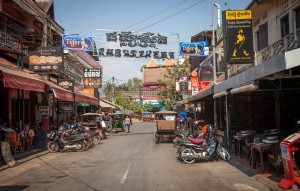 I awoke early Thursday morning sweating profusely. It only took a moment before I realized the fan wasn’t working because we had no electricity. This meant no water either as our budget (US $10/night for fan room) guest house (Bayon Garden) uses a water reservoir with a pump that is run by electricity. Our room was now an unbearable sauna and we couldn’t even cool off in the shower.
I awoke early Thursday morning sweating profusely. It only took a moment before I realized the fan wasn’t working because we had no electricity. This meant no water either as our budget (US $10/night for fan room) guest house (Bayon Garden) uses a water reservoir with a pump that is run by electricity. Our room was now an unbearable sauna and we couldn’t even cool off in the shower. By the time we finished breakfast, it looked like power had come back to the area. It was a different story back at our guest house which was located on the other side of the river, a few blocks outside the tourist district. Normally this would be considered an ideal location, a quiet side street within walking distance to all the noisy restaurants and bars. But today it was a definite disadvantage as we learned the power might be out for three days or more. According to the Cambodia Herald, an overloaded truck crashed into eleven power poles and damaged a transmission line from Thailand. It could take up to a week to repair. The city’s generator’s could provide only 25 per cent of the city’s power needs and clearly the main tourist district was considered the highest priority.
By the time we finished breakfast, it looked like power had come back to the area. It was a different story back at our guest house which was located on the other side of the river, a few blocks outside the tourist district. Normally this would be considered an ideal location, a quiet side street within walking distance to all the noisy restaurants and bars. But today it was a definite disadvantage as we learned the power might be out for three days or more. According to the Cambodia Herald, an overloaded truck crashed into eleven power poles and damaged a transmission line from Thailand. It could take up to a week to repair. The city’s generator’s could provide only 25 per cent of the city’s power needs and clearly the main tourist district was considered the highest priority.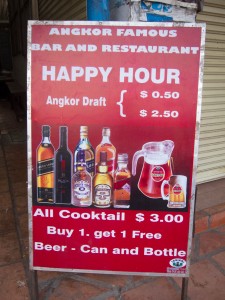 After three days at Angkor Wat, we were planning a “down” day, to work on the blog and to do travel research. So we grabbed our laptops and headed back to the restaurant where we had breakfast. We installed ourselves in a booth under a high powered fan and there we stayed for the rest of the day, drinking cheap beer (US $0.50 per draught), eating whenever we were hungry, and getting our “work” done. The waiters became friendly with us and we learned a little about their lives. They all drooled over Chris’ Mac Book Air and watched as Chris worked on photos and some video clips. It turned into a fun day that was both relaxing and productive!
After three days at Angkor Wat, we were planning a “down” day, to work on the blog and to do travel research. So we grabbed our laptops and headed back to the restaurant where we had breakfast. We installed ourselves in a booth under a high powered fan and there we stayed for the rest of the day, drinking cheap beer (US $0.50 per draught), eating whenever we were hungry, and getting our “work” done. The waiters became friendly with us and we learned a little about their lives. They all drooled over Chris’ Mac Book Air and watched as Chris worked on photos and some video clips. It turned into a fun day that was both relaxing and productive! The Temple Restaurant, our “office” for the day.
The Temple Restaurant, our “office” for the day. I was struggling with the last Laos post, having suffered from a bad case of writer’s block for a while, so when I finally finished that one, we celebrated with a pitcher of our favourite cocktail – vodka and tonic with lots of lime. For US $8.00, we each got about 3 tall glasses.
I was struggling with the last Laos post, having suffered from a bad case of writer’s block for a while, so when I finally finished that one, we celebrated with a pitcher of our favourite cocktail – vodka and tonic with lots of lime. For US $8.00, we each got about 3 tall glasses. 